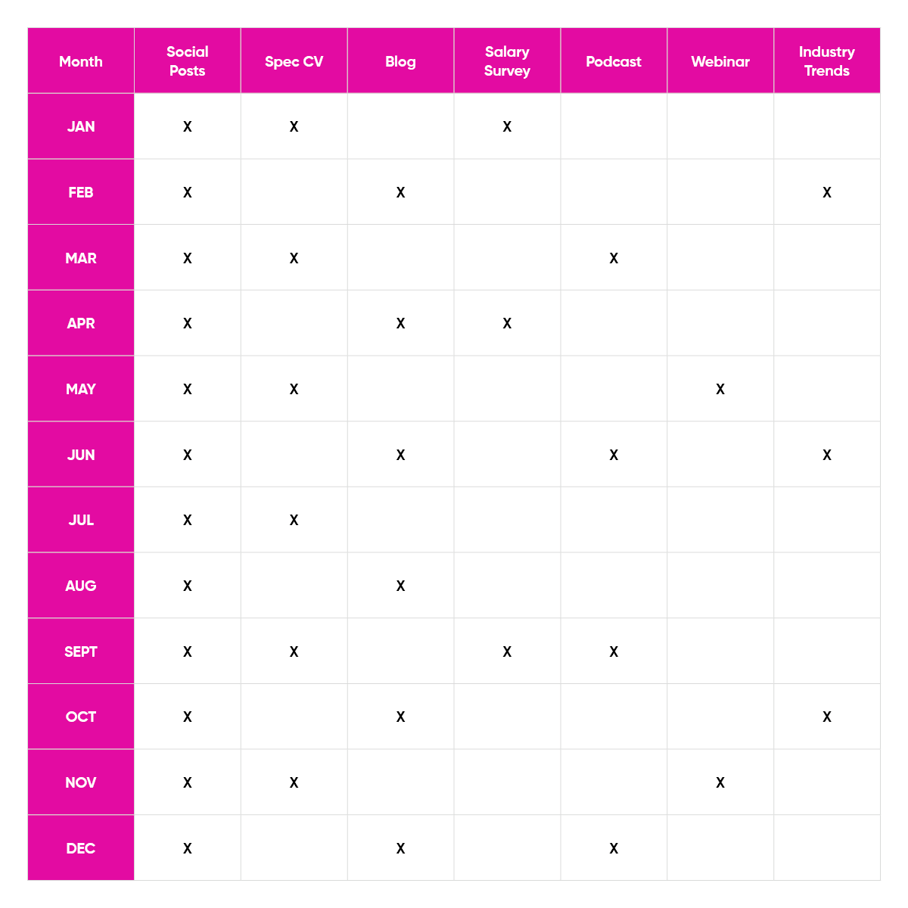As if you hadn’t noticed, B2B marketing is getting tougher. A recent Gartner CMO survey revealed a concerning trend: marketing budgets are shrinking, forcing CMOs to do more with less. Further compounding these challenges, LinkedIn’s 2024 B2B Marketing Benchmark Report highlights that 75% of CMOs now face greater pressure to prove their ROI in less time. In response to these pressures, marketers are turning to omni-channel strategies to maximise their impact while managing shrinking resources. An omni-channel strategy, which uses various platforms to engage potential candidates, is no longer just an option; it’s a necessity.
But it’s not all bleak. B2B marketers are resilient and inventive by necessity. In the highly competitive world of recruitment marketing, the old approach of relying on a single channel for outreach is no longer viable. Today's digital age demands a more robust, integrated approach. An omni-channel strategy, which utilises various platforms to engage potential candidates, is no longer just an option; it's a necessity.
Embracing this complexity, savvy marketers are harnessing every tool at their disposal to meet and exceed these new challenges, demonstrating that effective marketing strategies can not only cope with but thrive under pressure.
The Limitations of Single-Channel Marketing Strategies
Traditionally, recruitment marketing might have leaned heavily on ‘hot job’ or ‘candidate of the week’ emails and the odd blog post. However, this approach often fails to consider the unpredictability of user behaviour and the diverse paths potential clients and candidates might take online. Research indicates that B2B customers often require an average of 11 touchpoints before they engage with a brand. This statistic underlines the need for a more comprehensive approach to capture and retain the attention of clients and candidates.
The Omni-Channel Approach: A Necessity, Not an Option
Omni-channel marketing in recruitment means creating a seamless interaction across various channels—be it paid social ads, emails, or even in some cases direct mail - we know it’s retro but can work! This strategy ensures that a potential candidate’s journey with a recruitment firm is cohesive, regardless of the platform or mode of communication.
Key Components of an Effective Omni-Channel Recruitment Marketing Strategy
Implementing this enhanced marketing strategy doesn't have to be complicated.
1. Social Media Advertising
Platforms like LinkedIn are invaluable in recruitment marketing, allowing firms to target specific demographics with tailored content. Continuous exposure on these platforms ensures that your agency remains top-of-mind. According to LinkedIn's own reports, ads on their platform can increase purchase intent by 33% among B2B customers (LinkedIn, 2020).
2. Email Marketing
An email campaign must be more than just informative—it should be compelling and timely. Personalised emails are reported to deliver 6x higher transaction rates, yet 70% of brands fail to use them (Campaign Monitor, 2019). Crafting emails that resonate personally with recipients can dramatically boost engagement rates.
We’re talking about identifying your client's pain points and effectively conveying how you alleviate them. Proof of concept is important here - always take time to build case studies and use testimonials to back up your claims.
3. Enhanced Organic Search Presence
Search Engine Optimisation (SEO) and strategic content marketing are crucial for driving organic traffic. A strong organic presence ensures that when potential candidates search for recruitment opportunities, your agency appears at the top of those search results. The Google Algorithm Update Report of 2022 highlights the importance of content quality and backlink profiles in ranking highly in search results (Moz, 2022).
4. Direct Mail
In an increasingly digital world, direct mail can cut through the noise with a tangible, memorable impact. A study by MarketingProfs in 2021 showed that direct mail campaigns have a 29% return on investment, proving their worth in a comprehensive marketing strategy.
We recently did a director desk drop for one of our clients where we researched who their top 20 prospects followed and engaged with online and then sent them business books that reflect those interests. Anything to grab their attention in a saturated market.
Enhancing Engagement Through Omni-Channel Recruitment Marketing
In the world of recruitment, maintaining consistent and meaningful engagement with clients can make all the difference. Traditionally, the recruitment cycle involved sending speculative CVs intermittently throughout the year:
-
January: Speculative CV
-
February to March: Radio silence
-
April: Speculative CV
-
May, June, and July: Radio silence
-
August: Speculative CV
-
September: Speculative CV
-
October, November & December: Radio silence
In this traditional model, recruiters engage with clients sporadically, based solely on the immediate availability of job openings. This method fails to maintain a consistent presence in the client’s mind, especially during the months when clients aren’t in "buying mode."
Example of an Omni-Channel Approach

This revamped model keeps your brand in front of clients and candidates throughout the year. Rather than relying on sporadic interactions, integrating touchpoints like salary surveys, industry trends, and speculative CVs ensures consistent engagement and positions your agency as a valuable resource, even when clients aren’t actively hiring.
Measuring Success Across Channels
Understanding the impact of each channel is critical in refining and optimising strategy. This requires a look at both direct and indirect attributions:
- Direct Attribution: This includes tangible actions such as email replies, LinkedIn interactions, and responses to direct calls.
- Indirect Attribution (Direct to CRM): This might involve actions like demo form submissions or website conversions that are influenced by initial outbound activities but occur through different channels.
Effective tracking and attribution allow for a clear view of how each component of the strategy contributes to overall goals, ensuring resources are invested correctly. Tools like Google Analytics and CRM platforms can provide comprehensive insights into both the direct and indirect contributions of various channels.
Implementation: Steps to Transition to an Omni-Channel Strategy
Transitioning to an omni-channel strategy involves several key steps:
1. Assessment: Evaluate current marketing efforts and identify potential channels that are underutilised.
2. Integration: Develop a plan to integrate these channels so that they work seamlessly together, providing a consistent message across all platforms.
3. Consistency: Ensure the tone, messaging, and visual branding are consistent across all channels to reinforce brand recognition and trust.
An omni-channel strategy in recruitment marketing is essential for reaching and engaging today’s diverse, tech-savvy candidates. By leveraging multiple platforms and ensuring a cohesive user experience, recruitment agencies can significantly enhance their visibility and attractiveness to potential candidates.
Ready to make your marketing work smarter? Get in touch to discover how our tailored omni-channel strategies can help you achieve real results.

.jpg) Debbie Howsam
Debbie Howsam




